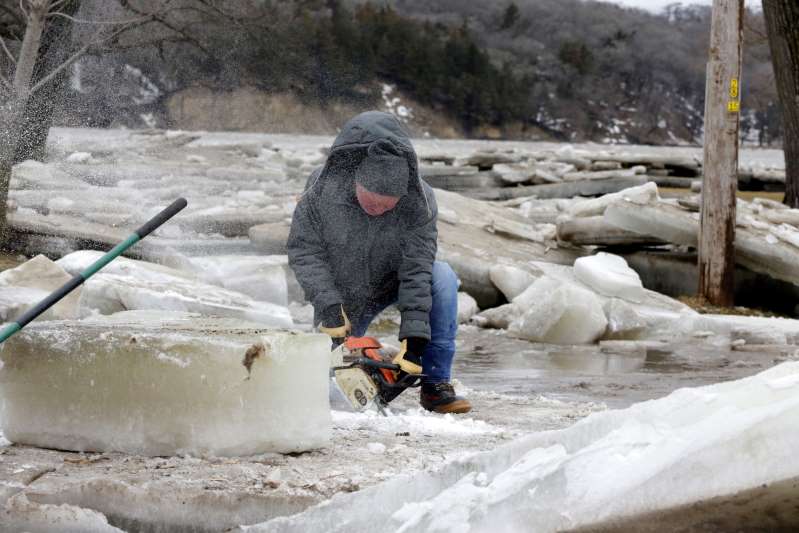
Jim Freeman tries to saw through thick ice slabs on his property in Fremont, Neb., Thursday, March 14, 2019, after the ice-covered Platte River flooded it's banks. (Photo: AP)
Flooding in the central US on Friday caused by rain and snowmelt from a massive late-winter storm forced hundreds of people to evacuate, threatened a nuclear power plant and shut down traffic on part of the Missouri River, foreshadowing a difficult spring flooding season.
The high water pushed some waterways to record levels in Nebraska, South Dakota, Iowa
Flooding remained a big concern in the lower Missouri River region — which is a major source for the Mississippi River — with the weather service issuing warnings of high water along the river and its tributaries from southeastern South Dakota to St. Louis in Missouri.
The US Coast Guard on Friday shut down all traffic on the Missouri River from about 50 miles (80.5 kilometers) south of Omaha, Nebraska, downstream to St. Joseph, Missouri, a stretch of about 70 miles (112.7 kilometers).
The Coast Guard and Corps also requested all river vessel operators create as little wake as possible between St. Joseph downstream to Kansas City to minimize levee damage.
The restrictions came as the river reached moderate flood stage at nearly 32 feet on Friday at Omaha, where it's expected to crest at nearly 34 feet on Monday, according to the National Weather Service. The river is expected to crest at St. Joseph on Tuesday at just over 30 feet. Major flood stage at St. Joseph is 27 feet.
The US Army Corps of Engineers, which manages the river, increased releases from Gavins Point Dam in southeastern South Dakota due to limited storage capacity behind the dam for the excess runoff. The releases could worsen flooding downstream, though the agency was helping with levee monitoring and other flood response measures, and it stopped releases from Fort Randall Dam upstream from Gavins Point.
The swollen Missouri threatened a nuclear power plant in southeastern Nebraska. The Nebraska Public Power District said it was likely the Cooper Nuclear Station about 59 miles (95.5 kilometers) south of Omaha would be shut down early Saturday.
Officials are confident that the flooding around the plant presents no danger to the public, power district spokesman Mark Becker said.
The storm also significantly increased spring flood worries in the Red River Valley in the Upper Midwest, where the neighboring cities of Fargo, North Dakota, and Moorhead, Minnesota, experienced a record flood 10 years ago.
The two cities have implemented several measures such as home buyouts and levees since then. They could be tested this year. The National Weather Service in an updated outlook Friday said "significant" snowmelt flooding is likely in the valley. The chance the river will reach major flood stage in Fargo increased from 50 percent last week to 90 percent.
The midweek storm crippled parts of Colorado and Wyoming with blizzard
The storm, which contributed to the deaths of a utility worker in Texas and a Colorado State Patrol officer, dropped heavy rain as it moved east across the central Plains. The rain also melted the snowpack, and with the ground deeply frozen, the water had nowhere to go except onto city streets, into home basements, and into rivers and streams.
The flooding prompted evacuations of hundreds of people in Wisconsin, Nebraska, South Dakota
"Losses are going to be tied more to being right in the middle of calving season," said James Halverson, executive director of the South Dakota Stockgrowers Association, which was still determining how widespread losses might be. "If there were calves born during the storm, it would be tough for them to stay alive."
The powerful wind and snow that created huge snowdrifts in cattle country also closed hundreds of miles of interstates in the Dakotas. The highways were being reopened Friday, but the flooding situation wasn't improving as rapidly as the travel conditions.
"It was ugly. It still is," Jim Freeman said after using a chain saw to cut up a chunk of ice that floodwaters left in his driveway in Fremont, Nebraska. "There's a lot of damage."
Iowa Gov. Kim Reynolds signed an emergency disaster proclamation and activated the state emergency operations center Thursday. South Dakota Gov. Kristi Noem opened that state's emergency operations center and said an emergency declaration was being prepared.
The storm also spawned at least three tornadoes in Michigan and Indiana on Thursday, according to the National Weather Service. There are no immediate reports of any injuries, but homes and trees were damaged and power was knocked out to thousands. Flooding, hail and strong winds also were reported in parts of the two states. The weather service recorded a 60 mph (97 kph) wind gust at Indianapolis International Airport.


